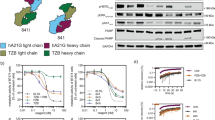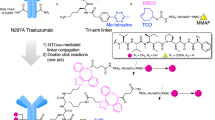Abstract
Targeted therapeutics are potential therapeutic agents because of their selectivity and efficacy against tumors resistant to conventional therapy. The goal of this study was to determine the comparative activity of monovalent, engineered anti-Her2/neu immunotoxins fused to recombinant gelonin (rGel) to the activity of bivalent IgG-containing immunoconjugates. Utilizing Herceptin and its derived humanized single-chain antibody (single-chain fragment variable, designated 4D5), we generated bivalent chemical Herceptin/rGel conjugate, and the corresponding monovalent recombinant immunotoxins in two orientations, 4D5/rGel and rGel/4D5. All the constructs showed similar affinity to Her2/neu-overexpressing cancer cells, but significantly different antitumor activities. The rGel/4D5 orientation construct and Herceptin/rGel conjugate were superior to 4D5/rGel construct in in vitro and in vivo efficacy. The enhanced activity was attributed to improved intracellular toxin uptake into target cells and efficient downregulation of Her2/neu-related signaling pathways. The Her2/neu-targeted immunotoxins effectively targeted cells with Her2/neu expression level >1.5 × 105 sites per cell. Cells resistant to Herceptin or chemotherapeutic agents were not cross-resistant to rGel-based immunotoxins. Against SK-OV-3 tumor xenografts, the rGel/4D5 construct with excellent tumor penetration showed impressive tumor inhibition. Although Herceptin/rGel conjugate demonstrated comparatively longer serum half-life, the in vivo efficacy of the conjugate was similar to the rGel/4D5 fusion. These comparative studies demonstrate that the monovalent, engineered rGel/4D5 construct displayed comparable in vitro and in vivo antitumor efficacy as bivalent Herceptin/rGel conjugate. Immunotoxin orientation can significantly impact the overall functionality and performance of these agents. The recombinant rGel/4D5 construct with excellent tumor penetration and rapid blood clearance may reduce the unwanted toxicity when administrating to patients, and warrants consideration for further clinical evaluation.
This is a preview of subscription content, access via your institution
Access options
Subscribe to this journal
Receive 50 print issues and online access
$259.00 per year
only $5.18 per issue
Buy this article
- Purchase on Springer Link
- Instant access to full article PDF
Prices may be subject to local taxes which are calculated during checkout






Similar content being viewed by others
References
Scholl S, Beuzeboc P, Pouillart P . Targeting HER2 in other tumor types. Ann Oncol 2001; 12 (Suppl 1): S81–S87.
Daniele L, Sapino A . Anti-HER2 treatment and breast cancer: state of the art, recent patents, and new strategies. Recent Pat Anticancer Drug Discov 2009; 4: 9–18.
Pohlmann PR, Mayer IA, Mernaugh R . Resistance to trastuzumab in breast cancer. Clin Cancer Res 2009; 15: 7479–7491.
Murphy CG, Fornier M . HER2-positive breast cancer: beyond trastuzumab. Oncology (Williston Park) 2010; 24: 410–415.
Brinkmann U . Recombinant antibody fragments and immunotoxin fusions for cancer therapy. In Vivo 2000; 14: 21–27.
Jain KK . Use of bacteria as anticancer agents. Expert Opin Biol Ther 2001; 1: 291–300.
Maier LA, Xu FJ, Hester S, Boyer CM, McKenzie S, Bruskin AM et al. Requirements for the internalization of a murine monoclonal antibody directed against the HER-2/neu gene product c-erbB-2. Cancer Res 1991; 51: 5361–5369.
Rodriguez GC, Boente MP, Berchuck A, Whitaker RS, O'Briant KC, Xu F et al. The effect of antibodies and immunotoxins reactive with HER-2/neu on growth of ovarian and breast cancer cell lines. Am J Obstet Gynecol 1993; 168: 228–232.
Beckman RA, Weiner LM, Davis HM . Antibody constructs in cancer therapy: protein engineering strategies to improve exposure in solid tumors. Cancer 2007; 109: 170–179.
Jain M, Venkatraman G, Batra SK . Optimization of radioimmunotherapy of solid tumors: biological impediments and their modulation. Clin Cancer Res 2007; 13: 1374–1382.
Krauss WC, Park JW, Kirpotin DB, Hong K, Benz CC . Emerging antibody-based HER2 (ErbB-2/neu) therapeutics. Breast Dis 2000; 11: 113–124.
Pennell CA, Erickson HA . Designing immunotoxins for cancer therapy. Immunol Res 2002; 25: 177–191.
Mazor Y, Noy R, Wels WS, Benhar I . chFRP5-ZZ-PE38, a large IgG-toxin immunoconjugate outperforms the corresponding smaller FRP5(Fv)-ETA immunotoxin in eradicating ErbB2-expressing tumor xenografts. Cancer Lett 2007; 257: 124–135.
Kreitman RJ . Recombinant toxins for the treatment of cancer. Curr Opin Mol Ther 2003; 5: 44–51.
Reiter Y . Recombinant immunotoxins in targeted cancer cell therapy. Adv Cancer Res 2001; 81: 93–124.
Adams GP, Tai MS, McCartney JE, Marks JD, Stafford WF, Houston LL et al. Avidity-mediated enhancement of in vivo tumor targeting by single-chain Fv dimers. Clin Cancer Res 2006; 12: 1599–1605.
Bera TK, Onda M, Brinkmann U, Pastan I . A bivalent disulfide-stabilized Fv with improved antigen binding to erbB2. J Mol Biol 1998; 281: 475–483.
Bera TK, Viner J, Brinkmann E, Pastan I . Pharmacokinetics and antitumor activity of a bivalent disulfide-stabilized Fv immunotoxin with improved antigen binding to erbB2. Cancer Res 1999; 59: 4018–4022.
Yee ST, Okada Y, Ogasawara K, Omura S, Takatsuki A, Kakiuchi T et al. MHC class I presentation of an exogenous polypeptide antigen encoded by the murine AIDS defective virus. Microbiol Immunol 1997; 41: 563–570.
Rosenblum MG, Cheung LH, Liu Y, Marks JW . Design, expression, purification, and characterization, in vitro and in vivo, of an antimelanoma single-chain Fv antibody fused to the toxin gelonin. Cancer Res 2003; 63: 3995–4002.
Hossann M, Li Z, Shi Y, Kreilinger U, Buttner J, Vogel PD et al. Novel immunotoxin: a fusion protein consisting of gelonin and an acetylcholine receptor fragment as a potential immunotherapeutic agent for the treatment of Myasthenia gravis. Protein Expr Purif 2006; 46: 73–84.
Carter P, Presta L, Gorman CM, Ridgway JB, Henner D, Wong WL et al. Humanization of an anti-p185HER2 antibody for human cancer therapy. Proc Natl Acad Sci USA 1992; 89: 4285–4289.
Hermanto U, Zong CS, Wang LH . ErbB2-overexpressing human mammary carcinoma cells display an increased requirement for the phosphatidylinositol 3-kinase signaling pathway in anchorage-independent growth. Oncogene 2001; 20: 7551–7562.
Knuefermann C, Lu Y, Liu B, Jin W, Liang K, Wu L et al. HER2/PI-3K/Akt activation leads to a multidrug resistance in human breast adenocarcinoma cells. Oncogene 2003; 22: 3205–3212.
Pai-Scherf LH, Villa J, Pearson D, Watson T, Liu E, Willingham MC et al. Hepatotoxicity in cancer patients receiving erb-38, a recombinant immunotoxin that targets the erbB2 receptor. Clin Cancer Res 1999; 5: 2311–2315.
Cardinale D, Colombo A, Torrisi R, Sandri MT, Civelli M, Salvatici M et al. Trastuzumab-induced cardiotoxicity: clinical and prognostic implications of troponin I evaluation. J Clin Oncol 2010; 28: 3910–3916.
McLarty K, Cornelissen B, Scollard DA, Done SJ, Chun K, Reilly RM . Associations between the uptake of 111In-DTPA-trastuzumab, HER2 density and response to trastuzumab (Herceptin) in athymic mice bearing subcutaneous human tumour xenografts. Eur J Nucl Med Mol Imaging 2009; 36: 81–93.
Nordstrom JL, Gorlatov S, Zhang W, Yang Y, Huang L, Burke S et al. Anti-tumor activity and toxicokinetics analysis of MGAH22, an anti-HER2 monoclonal antibody with enhanced Fc-gamma receptor binding properties. Breast Cancer Res 2011; 13: R123.
Lewis Phillips GD, Li G, Dugger DL, Crocker LM, Parsons KL, Mai E et al. Targeting HER2-positive breast cancer with trastuzumab-DM1, an antibody-cytotoxic drug conjugate. Cancer Res 2008; 68: 9280–9290.
Rosenblum MG, Shawver LK, Marks JW, Brink J, Cheung L, Langton-Webster B . Recombinant immunotoxins directed against the c-erb-2/HER2/neu oncogene product: in vitro cytotoxicity, pharmacokinetics, and in vivo efficacy studies in xenograft models. Clin Cancer Res 1999; 5: 865–874.
Benhar I, Pastan I . Characterization of B1(Fv)PE38 and B1(dsFv)PE38: single-chain and disulfide-stabilized Fv immunotoxins with increased activity that cause complete remissions of established human carcinoma xenografts in nude mice. Clin Cancer Res 1995; 1: 1023–1029.
Yokota T, Milenic DE, Whitlow M, Schlom J . Rapid tumor penetration of a single-chain Fv and comparison with other immunoglobulin forms. Cancer Res 1992; 52: 3402–3408.
Jain RK, Baxter LT . Mechanisms of heterogeneous distribution of monoclonal antibodies and other macromolecules in tumors: significance of elevated interstitial pressure. Cancer Res 1988; 48: 7022–7032.
Cao Y, Marks JD, Marks JW, Cheung LH, Kim S, Rosenblum MG . Construction and characterization of novel, recombinant immunotoxins targeting the Her2/neu oncogene product: in vitro and in vivo studies. Cancer Res 2009; 69: 8987–8995.
Cao Y, Marks JD, Huang Q, Rudnick SI, Xiong C, Hittelman WN et al. Single-chain antibody-based immunotoxins targeting Her2/neu: design optimization and impact of affinity on antitumor efficacy and off-target toxicity. Mol Cancer Ther 2012; 11: 143–153.
Adams GP, Schier R, McCall AM, Crawford RS, Wolf EJ, Weiner LM et al. Prolonged in vivo tumour retention of a human diabody targeting the extracellular domain of human HER2/neu. Br J Cancer 1998; 77: 1405–1412.
Brand FX, Ravanel N, Gauchez AS, Pasquier D, Payan R, Fagret D et al. Prospect for anti-her2 receptor therapy in breast cancer. Anticancer Res 2006; 26: 715–722.
Maurer-Gebhard M, Schmidt M, Azemar M, Altenschmidt U, Stocklin E, Wels W et al. Systemic treatment with a recombinant erbB-2 receptor-specific tumor toxin efficiently reduces pulmonary metastases in mice injected with genetically modified carcinoma cells. Cancer Res 1998; 58: 2661–2666.
Azemar M, Djahansouzi S, Jager E, Solbach C, Schmidt M, Maurer AB et al. Regression of cutaneous tumor lesions in patients intratumorally injected with a recombinant single-chain antibody-toxin targeted to ErbB2/HER2. Breast Cancer Res Treat 2003; 82: 155–164.
Wels W, Harwerth IM, Mueller M, Groner B, Hynes NE . Selective inhibition of tumor cell growth by a recombinant single-chain antibody-toxin specific for the erbB-2 receptor. Cancer Res 1992; 52: 6310–6317.
Debnath J, Muthuswamy SK, Brugge JS . Morphogenesis and oncogenesis of MCF-10A mammary epithelial acini grown in three-dimensional basement membrane cultures. Methods 2003; 30: 256–268.
Acknowledgements
We thank Dr Xin Li of the University of Kentucky for assistance with immunohistochemical study. This research work was conducted, in part, by the Clayton Foundation for Research.
Author information
Authors and Affiliations
Corresponding author
Ethics declarations
Competing interests
The authors declare no conflicts of interest.
Additional information
Supplementary Information accompanies this paper on the Oncogene website
Supplementary information
Rights and permissions
About this article
Cite this article
Cao, Y., Marks, J., Liu, Z. et al. Design optimization and characterization of Her2/neu-targeted immunotoxins: comparative in vitro and in vivo efficacy studies. Oncogene 33, 429–439 (2014). https://doi.org/10.1038/onc.2012.612
Received:
Revised:
Accepted:
Published:
Issue Date:
DOI: https://doi.org/10.1038/onc.2012.612
Keywords
This article is cited by
-
Recombinant immunotoxins development for HER2-based targeted cancer therapies
Cancer Cell International (2021)
-
Design, Expression, Purification and Characterization of the Recombinant Immunotoxin 4D5 scFv-TRAIL
International Journal of Peptide Research and Therapeutics (2020)
-
Evaluation of HER2-specific peptide ligand for its employment as radiolabeled imaging probe
Scientific Reports (2018)
-
Therapeutic potential of an anti-HER2 single chain antibody–DM1 conjugates for the treatment of HER2-positive cancer
Signal Transduction and Targeted Therapy (2017)



